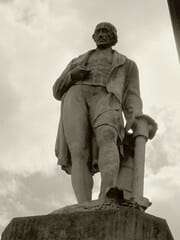Metric Conversion Quick Tutorial and Practice Questions
- Posted by Brian Stocker MA
- Date March 27, 2014
- Comments 10 comments
Metric Conversion – A Quick Tutorial

Conversion between metric and standard units can be tricky since the units of distance, volume, area and temperature can seem rather arbitrary when compared to one another. Although the metric system (using SI units) is the standard system of measure in most parts of the world many countries still use at least some of their traditional units of measure. In North America those units come from the old British system.
Distance, Volume, Area and Temperature.
John Wilkins, pictured left, in 1668, published an essay proposing a decimal system of measurement.
Below are practice test questions for the metric system similar to what you will find on a standardized test.
Distance
When measuring distance the relation between metric and standard units looks like this:
| 0.039 in | 1 millimeter | 1 inch | 25.4 mm | |
| 3.28 ft | 1 meter | 1 foot | .305 m | |
| 0.621 mi | 1 kilometer | 1 mile | 1.61 km |
Here, you can see that 1 millimeter is equal to .039 inches and 1 inch equals 25.4 millimeters.
Area
When measuring area the relation between metric and standard looks like this:
| .0016 in2 | 1 square millimeter | 1 square inch | 645.2 mm2 | |
| 10.764 ft2 | 1 square meter | 1 square foot | .093 m2 | |
| .386 mi2 | 1 square kilometer | 1 square mile | 2.59 km2 | |
| 2.47 ac | hectare | 1 acre | .405 ha |
Weight and Mass
When measuring weight and mass the relation between metric and standard units looks like this:
| .035 oz | 1 gram | 1 ounce | 28.35 g | |
| 2.202 lbs | 1 kilogram | 1 pound | .454 kg | |
| 1.103 T | 1 metric ton | 1 ton | .907 t |
It is important to note that in science, the metric units of grams and kilograms are always used to denote the mass of an object rather than its weight.
Temperature
In predominantly metric countries the standard unit of temperature is degrees Celsius while in countries with only limited use of the metric system, such as the United States, degrees Fahrenheit is used. This chart shows the difference between Fahrenheit and Celsius:
| 0° Celsius | 32° Fahrenheit | |
| 10° Celsius | 50° Fahrenheit | |
| 20° Celsius | 68° Fahrenheit | |
| 30° Celsius | 86° Fahrenheit | |
| 40° Celsius | 104° Fahrenheit | |
| 50° Celsius | 122° Fahrenheit | |
| 60° Celsius | 140° Fahrenheit | |
| 70° Celsius | 158° Fahrenheit | |
| 80° Celsius | 176° Fahrenheit | |
| 90° Celsius | 194° Fahrenheit | |
| 100° Celsius | 212° Fahrenheit |
As you can see 0° C is freezing while 32° F is freezing. Similarity 100° C is boiling while the Fahrenheit system takes until 212° F. To convert from Celsius to Fahrenheit you need to multiply the temperature in Celsius by 1.8 and then add 32 to it. (x° F = (y° C*1.8) + 32) To convert from Fahrenheit to Celsius you do the opposite. First subtract 32 from the temperature then divide by 1.8. (x° C = (y° -32) / 1.8)
Volume
Similarly, when measuring volume the relation between metric and standard units looks like this:
| 3034 fl oz | 1 milliliter | 1 fluid ounce | 29.57 ml | |
| .0264 gal | 1 liter | 1 gallon | 3.785 L | |
| 35.314 ft3 | 1 cubic meter | 1 cubic foot | .028 m3 |
Practice Questions
1. Convert 10 kg. to grams.
a. 10,000 grams
b. 1,000 grams
c. 100 grams
d. 10.11 grams
2. 1 gallon = _________ liter(s).
a. 1 liter
b. 3.785 liters
c. 37.85 liters
d. 4.5 liters
3. Convert 2.5 liters to milliliters.
a. 1,050 ml.
b. 2,500 ml.
c. 2,050 ml.
d. 1,500 ml.
4. Convert 210 mg. to grams.
a. 0.21 mg.
b. 2.1 g.
c. 0.21 g.
d. 2.12 g.
5. Convert 10 pounds to kilograms.
a. 4.54 kg.
b. 11.25 kg.
c. 15 kg.
d. 10.25 kg.
6. Convert 0.539 grams to milligrams.
a. 539 g.
b. 539 mg.
c. 53.9 mg.
d. 0.53 g .
7. Convert 16 quarts to gallons.
a. 1 gallons
b. 8 gallons
c. 4 gallons
d. 4.5 gallons
8. Convert 45 kg. to pounds.
a. 10 pounds
b. 100 pounds
c. 1,000 pounds
d. 110 pounds
Answer Key
1. A
1kg = 1,000 g and 10 kg = 10 x 1,000 = 10,000 g
2. B
1 US gallon = 3.78541178 liters
3. B
1 liter = 1,000 milliliters, 2.5 liters = 2.5 x 1,000 = 2,500 milliliters
4. C
1,000 mg = 1 g, 210 mg = 210/1000 = 0.21 g. Be careful of Choice A, (0.21 mg.)
The numbers are the same but the units are different.
5. A
1 pound = 0.45 kg, 10 pounds = 4.53592, or about 4.54 kg. When multiplying a
decimal by 10, move the decimal point one place to the left.
6. B
1 g = 1,000 mg. 0.539 g = 0.539 x 1000 = 539 mg.
7. C
4 quarts = 1 gallon, 16 quarts = 16/4 = 4 gallons. Conversion problems are easy to get confused. One way to think of them is which is larger – quarts or gallons? Gallons are larger, so if you are converting from quarts to gallons the number of gallons will be a smaller number. Keeping that in mind, you can do a ‘commonsense’ check on your answer.
8. B
0.45 kg = 1 pound, 1 kg. = 1/0.45 and 45 kg = 1/0.45 x 45 = 99.208, or 100 pounds.
Most Common Errors Answering Metric Conversion Questions on a Test
Misunderstanding Units Mixing up metric units for example, confusing milliliters with liters when dealing with volume.
Incorrectly Converting For example, using 100 X to convert meters in a kilometer instead of 1000.
Decimal Errors For example, converting 1.5 kilometers to 150 meters instead of 1500 meters or vice versa. Practice with Decimals
Simple Arithmetic Errors Simple errors in addition, subtraction, multiplication, or division errors. Basic Math Practice
Using the Wrong Formula Watch your formula, especially in more complex multi-step conversions.
Not Simplifying Failing to simplify units to the most appropriate scale, such as reporting a distance of 1000 meters instead of 1 kilometer where the latter might be more appropriate.
Errors Rounding Rounding too much or too little.
Not labelling Units Omitting the unit labels in answers, may give a wrong answer.
Date Published: Thursday, March 27th, 2014
Date Modified: Thursday, November 13th, 2025
You may also like

Basic Math Video Tutorials

How to Answer Basic Math Multiple Choice
How to Solve Linear Inequalities – Quick Review and Practice
Basic linear inequalities have one of the following forms: ax + b > 0 ax + b < 0 ax + b > 0 ax + b < 0 where a and b are some real numbers. Our solution to …

10 Comments
IS HOEA TEST THAT SIMPLE as it is shown in these questions
Hard to say exactly what will be on the HOAE/PSB – and it changes all the time. These HOAE practice questions cover the same topics – but we can’t make any guarantees – and neither can anyone else.
I have benefited from this site.
Metric Conversion Practice
For the metric conversion do you need to mesmerize the amounts? (that seems excessive when converting random amounts without know the basic amounts)
Unfortunately yes!
Hello!
Are ‘Volume’ (Weight) questions like the 10 problems in this practice the only metric conversion problems in the CHSPE exam? For example, do I need to memorize the ‘Area’ and ‘Temperature’ conversions? By the way, this is great review! Thank you so much,
Noura
Hi – yes a formula sheet is provided
Wait so formula sheet will be provided on the chspe for this right??
YES! CHSPE provides a formula sheet